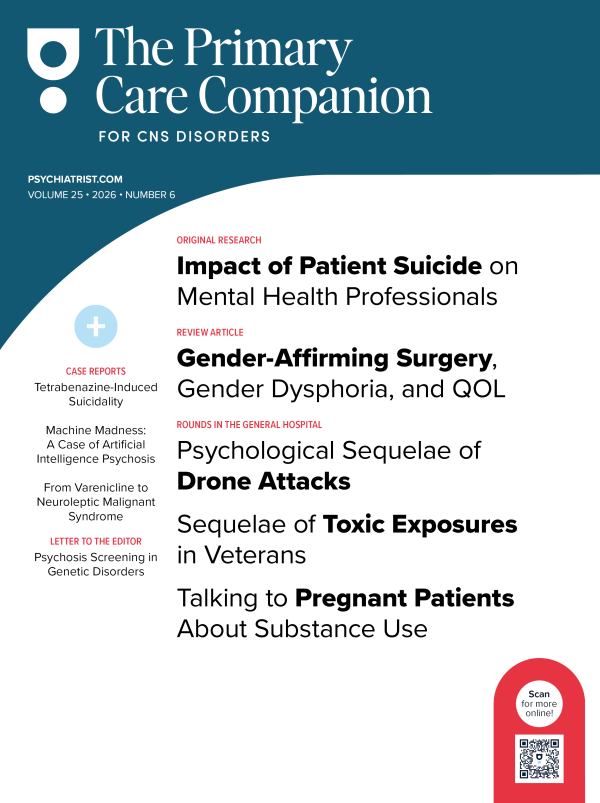Olanzapine is a second-generation atypical antipsychotic approved by the US Food and Drug Administration to treat schizophrenia and refractory depression associated with bipolar I disorder features in combination with a selective serotonin reuptake inhibitor.1,2 Olanzapine is a dopamine receptor and serotonin receptor antagonist.1,2 Olanzapine has antimuscarinic effects, including dry mouth, constipation, and urinary retention.3 Olanzapine has lower extrapyramidal symptoms and epileptogenic effects than other antipsychotics. However, it causes metabolic side effects, including diabetes, hyperlipidemia, and weight gain.1
We present the case of a patient who developed significant bradycardia with olanzapine use. Bradycardia is a heart rate < 60 bpm.4 Symptoms of bradycardia include fatigue, light-headedness, shortness of breath, or confusion.2
Reversible causes of bradycardia include metabolic and electrolyte abnormalities, hypothermia, hypoxia, and hypothyroidism.4 Certain medications such as tricyclic antidepressants, opioids, β-blockers, and antiarrhythmics can also result in bradycardia.4
Case Report
A 34-year-old man with a past psychiatric history of major depressive disorder (MDD) and cannabis use disorder presented to the outpatient clinic with symptoms of clinical depression and disorganized behavior. He had a medical history of hypertension and diabetes, for which he was taking amlodipine and metformin, respectively. He recently self-discontinued amlodipine and metformin. He was not taking any psychotropic medications. The patient was admitted to the hospital and was started on olanzapine 10 mg based on the provisional diagnosis of unspecified psychosis and MDD.
His vital signs were stable. His heart rate was 72 bpm. On the third day, his heart rate had dropped to 48 bpm, and his blood pressure was 90/60 mm Hg. The patient, however, remained asymptomatic. Laboratory analyses including differential blood counts, electrolytes, hepatic enzymes, creatinine, urea nitrogen, and chest x-ray were all within normal limits. A repeat electrocardiogram showed no significant changes compared with previous scans except for sinus bradycardia.
Olanzapine was withheld overnight. The following morning, all the vital signs, including heart rate, were within normal limits, suggesting a temporal association between olanzapine and bradycardia.
Discussion
Olanzapine can cause postural hypotension through α-1 adrenergic antagonism with compensatory tachycardia.5 However, in our patient, hypotension was associated with bradycardia, showing a sympatholytic effect exerted by the central nervous system.
Few past case reports have shown this side effect of olanzapine.6,7 One case reported hypotension accompanied by bradycardia with a small initial dose of olanzapine 5 mg.6 A similar bradycardic hypotensive event was also reported in a middle-aged schizophrenia patient receiving olanzapine treatment for 12 days.7 Our case is relevant based on the similar presentation of the patient after the use of olanzapine and could prompt further investigation into this side effect.
Reporting such clinically significant and relevant side effects can create awareness among providers to do necessary follow-ups and educate patients about potential bradycardia. Vital signs need to be monitored at regular intervals when olanzapine is started, and the patient should be monitored for bradycardia. This monitoring is important in first-time users and with concomitant medication use. Patients should be educated about potential side effects of olanzapine and let their providers know about all medications they are taking. Also, a careful and detailed history is equally important to rule out any underlying cardiovascular or other diseases that can increase the risk of bradycardia with olanzapine use.
The combination of olanzapine with other drugs that cause severe bradycardia or hypotension warrants particular attention because of the possible harmful synergistic effects on the cardiovascular system. Therefore, in the emergency department setting, olanzapine should be included in the differential diagnosis of substance use, including opioid intoxication.
Article Information
Published Online: August 15, 2023. https://doi.org/10.4088/PCC.22cr03453
© 2023 Physicians Postgraduate Press, Inc.
Prim Care Companion CNS Disord 2023;25(4):22cr03453
Submitted: November 20, 2022; accepted January 9, 2023.
To Cite: Sachdeva V, Ashraf S, Inam S, et al. Olanzapine-induced bradycardia. Prim Care Companion CNS Disord. 2023;25(4):22cr03453.
Author Affiliations: Adesh Institute of Medical Sciences and Research, Bathinda, India (Sachdeva); Northpointe Psychiatry, Lewisville, Texas (Ashraf); University of Waterloo, Ontario, Canada (Inam); Wake Forest University, Winston-Salem, North Carolina (Shah); Griffin Memorial Hospital, Norman, Oklahoma (Singla); Boston Children’s Hospital, Massachusetts (Mansuri); Texas Tech University Health Science Center at Permian Basin, Midland (Jain).
Corresponding Author: Sahar Ashraf, MD, Northpointe Psychiatry, 860 Hebron Pkwy, Ste 1101, Lewisville, TX 75057 ([email protected]).
Relevant Financial Relationships: None.
Funding/Support: None.
Additional Information: Information has been de-identified to protect anonymity.
References (7)

- Joye F, Orrillard M, Marion F, et al. Intoxication sévère probable par olanzapine (Zyprexa). Effet bénéfique du glucagon. [Severe intoxication likely from olanzapine (Zyprexa). beneficial effect of glucagon]. Ann Fr Anesth Reanim. 1999;18(6):686–690. PubMed CrossRef
- Bever KA, Perry PJ. Olanzapine: a serotonin-dopamine-receptor antagonist for antipsychotic therapy. Am J Health Syst Pharm. 1998;55(10):1003–1016. PubMed CrossRef
- Leucht S, Pitschel-Walz G, Abraham D, et al. Efficacy and extrapyramidal side-effects of the new antipsychotics olanzapine, quetiapine, risperidone, and sertindole compared to conventional antipsychotics and placebo: a meta-analysis of randomized controlled trials. Schizophr Res. 1999;35(1):51–68. PubMed CrossRef
- Markowitz JS, DeVane CL, Boulton DW, et al. Hypotension and bradycardia in a healthy volunteer following a single 5 mg dose of olanzapine. J Clin Pharmacol. 2002;42(1):104–106. PubMed CrossRef
- Thomas K, Saadabadi A. Olanzapine. In: StatPearls [Internet]. Treasure Island (FL): StatPearls Publishing; January 2022. Accessed May 2, 2022. https://www.ncbi.nlm.nih.gov/books/NBK532903/
- Sidhu S, Marine JE. Evaluating and managing bradycardia. Trends Cardiovasc Med. 2020;30(5):265–272. PubMed CrossRef
- Citrome L, McEvoy JP, Todtenkopf MS, et al. A commentary on the efficacy of olanzapine for the treatment of schizophrenia: the past, present, and future. Neuropsychiatr Dis Treat. 2019;15:2559–2569. PubMed CrossRef
Please sign in or purchase this PDF for $40.


